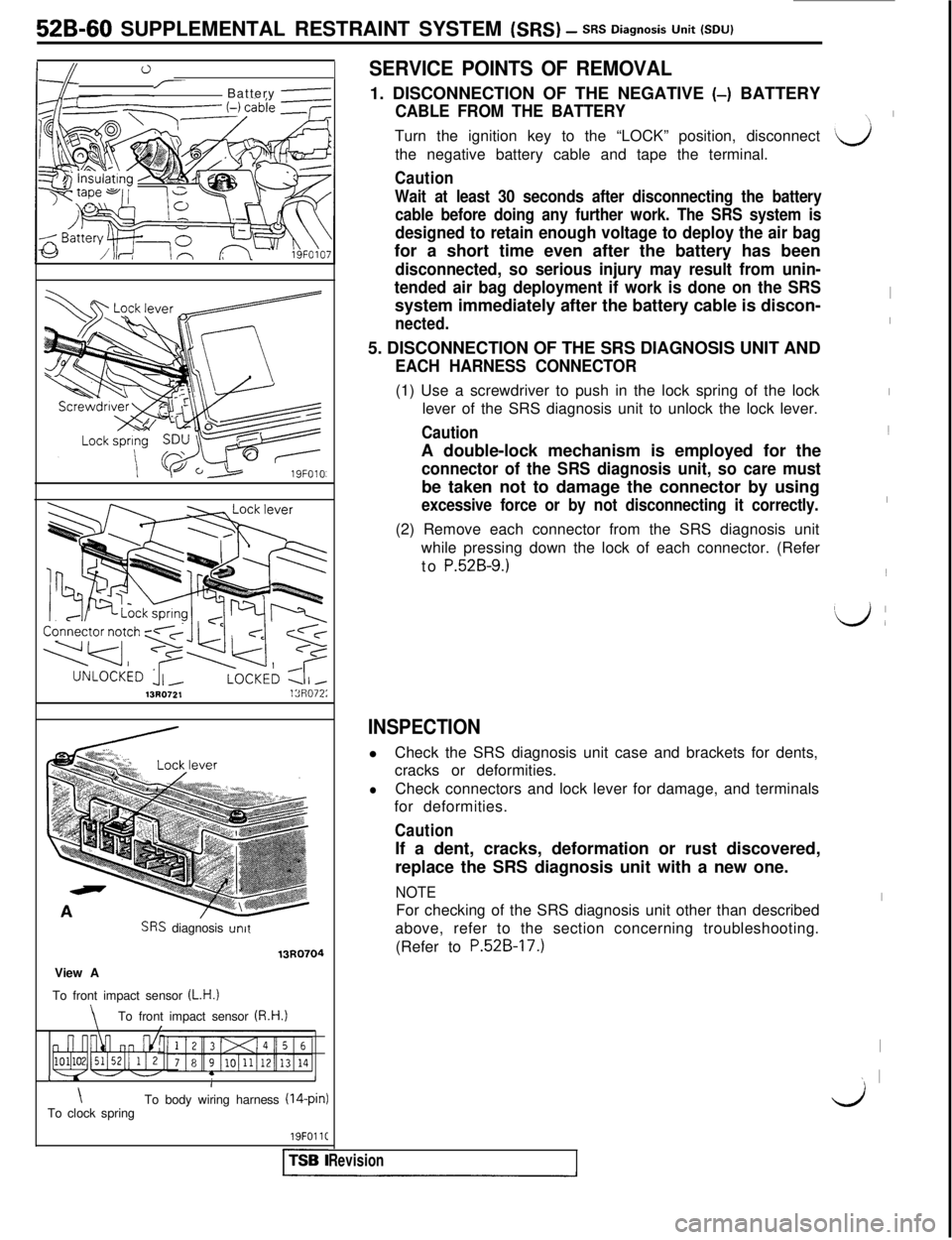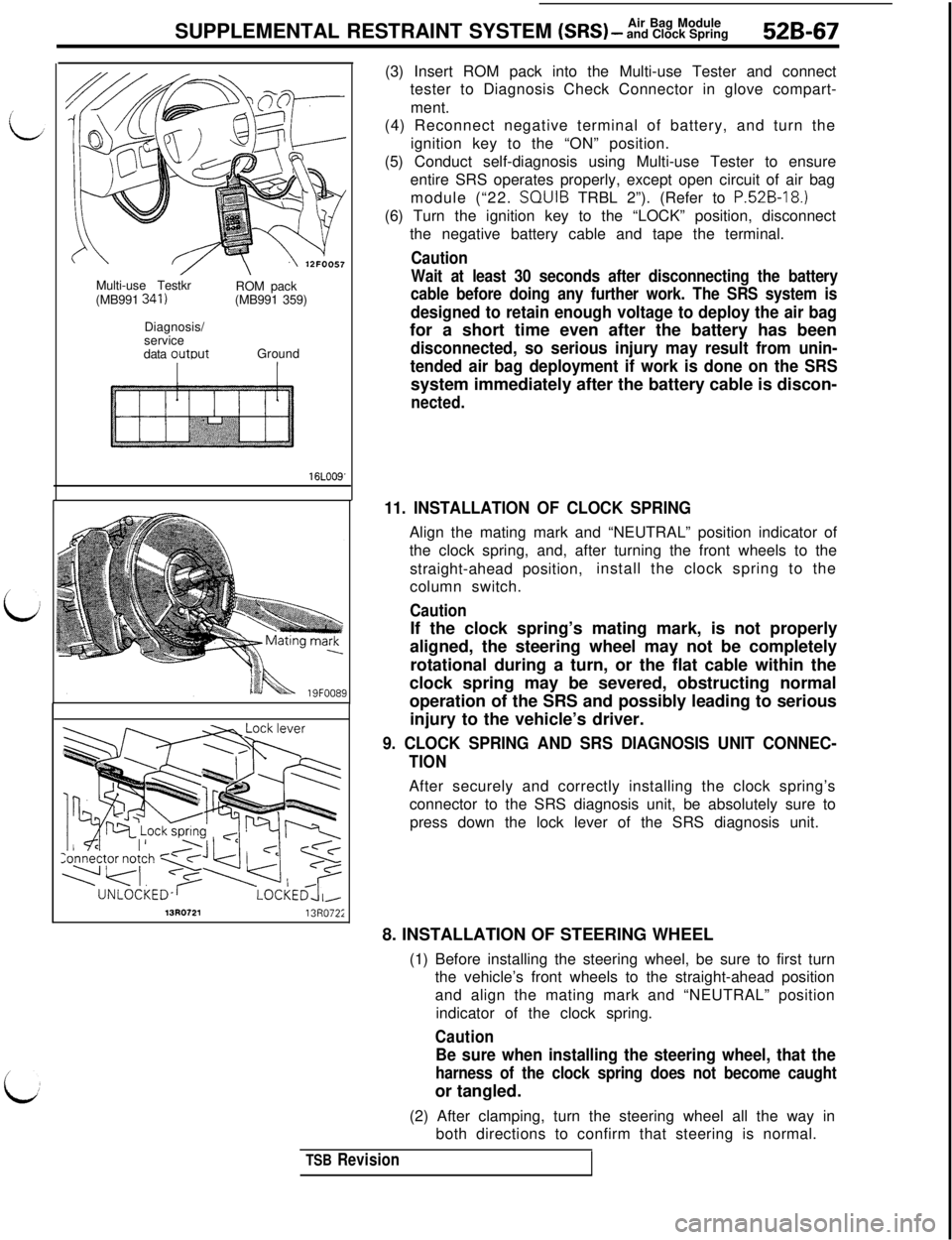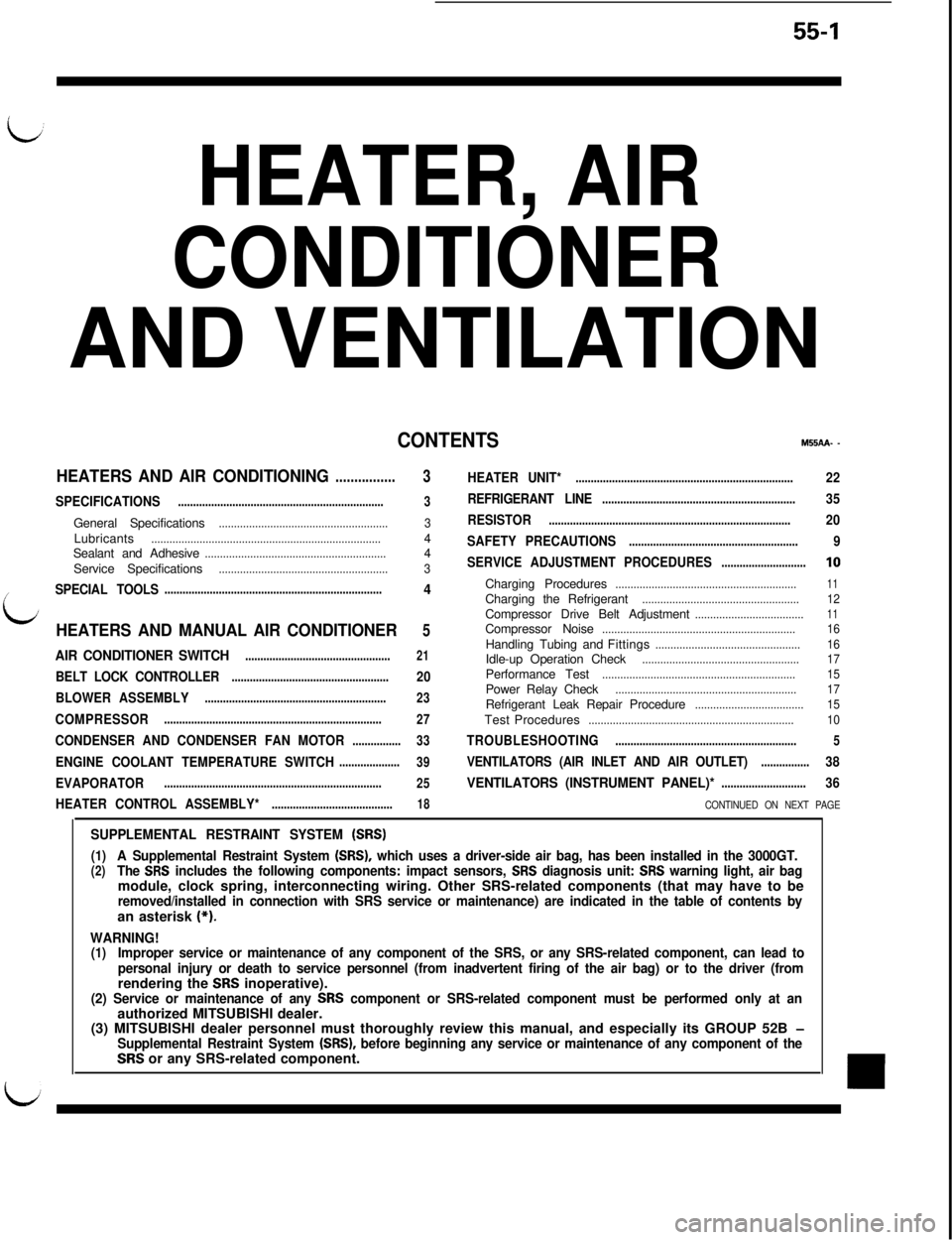1991 MITSUBISHI 3000GT service
[x] Cancel search: servicePage 1067 of 1146

SUPPLEMENTAL RESTRAINT SYSTEM (SRS) - Front impact Sensors52B-57Digital multi-meter
/
19FOlC
SERVICE POINTS OF REMOVAL1. DISCONNECTION OF THE NEGATIVE
(-) BATTERY
CABLE FROM THE BATTERYTurn the ignition key to the “LOCK” position, disconnect
the negative battery cable and tape the terminal.
Caution
Wait at least 30 seconds after disconnecting the battery
cable before doing any further work. The SRS system is
designed to retain enough voltage to deploy the air bagfor a short time even after the battery has been
disconnected, so serious injury may result from unin-
tended air bag deployment if work is done on the SRSsystem immediately after the battery cable is discon-
nected.
INSPECTION
(I) Check upper frame and sensor brackets for deformities or
rust.
(2) Check sensor harness for binds, connectors for damage,
and terminals for deformities.
(3) Check for dents, cracks or deformation of the front impact
sensor.
Caution
If a dent, crack, deformation or rust is detected, replacewith a
.new sensor.
(4) Remove the front impact sensor.
(5) Measure the resistance between terminals and check
whether it is within the standard value.
Standard value: 2,000 + 40
iZ
CautionAlways replace the sensor with a new one if the
resistance is not within the standard value.
1 TSB RevisionI
Page 1068 of 1146

52B-58SUPPLEMENTAL RESTRAINT SYSTEM (SRS) - Front Impact Sensors
SERVICE POINT OF INSTALLATION
PRE-INSTALLATION INSPECTION
(1) Before any front impact sensor is installed in the vehicle, it
must be visually inspected. If a dent, crack or other
LAdeformation, or rust, is detected, discard the sensor and
replace it with a new one that passes the visual inspection.
(2) Before any front impact sensor is installed in the vehicle,
the resistance between its terminals must be confirmed to
be within the standard value.
Standard value: 2,000
-t 400
Use the digital multi meter. If the resistance is not within
that standard value range, discard it and replace it with a
new one that has the standard value.
19FOO6i4.
INSTALLATI’ON OF FRONT IMPACT SENSOR
(1) Bend the wiring harness slightly (to the extent that
there is no slack), and clip securely by using the clip of
the front impact sensor.
(2) Install the front impact sensor so that there is close
adherence of the upper surface of the front impact
sensor and the installation surface of the upper frame
d’(lower).
Caution
The SRS may not activate properly if a front impact
sensor is not installed properly, which could result
Iin serious injury or death to the vehicle’s driver.
POST-INSTALLATION INSPECTIONReconnect the negative battery terminal. Turn the ignition
switch to “ON”. Does the
“SW” warning light illuminate for
about 7 seconds, turn OFF and then remain extinguished for at
least 45 seconds? If yes, SRS system is functioning properly. If
no, consult page 52B-17.
19FOO72
TSB Revision
Page 1070 of 1146

52B-60 SUPPLEMENTAL RESTRAINT SYSTEM (SRS) - SRS Diagnosis Unit (SW
0I/-Battery e
13R0721lSF1072:
SRS diagnosis unitView A13R0704
To front impact sensor
(L.H.)
\To front impact sensor (R.H.1\I
I- - -,I1
\To clock springTo body wiring harness (14-pin)19FOllt
r-TSB I
SERVICE POINTS OF REMOVAL1. DISCONNECTION OF THE NEGATIVE
(-) BATTERY
CABLE FROM THE BATTERYTurn the ignition key to the “LOCK” position, disconnect
the negative battery cable and tape the terminal.
Caution
Wait at least 30 seconds after disconnecting the battery
cable before doing any further work. The SRS system is
designed to retain enough voltage to deploy the air bagfor a short time even after the battery has been
disconnected, so serious injury may result from unin-
tended air bag deployment if work is done on the SRSsystem immediately after the battery cable is discon-
nected.5. DISCONNECTION OF THE SRS DIAGNOSIS UNIT AND
EACH HARNESS CONNECTOR(1) Use a screwdriver to push in the lock spring of the lock
lever of the SRS diagnosis unit to unlock the lock lever.
CautionA double-lock mechanism is employed for the
connector of the SRS diagnosis unit, so care mustbe taken not to damage the connector by using
excessive force or by not disconnecting it correctly.(2) Remove each connector from the SRS diagnosis unit
while pressing down the lock of each connector. (Refer
to
P.52B-9.)
INSPECTIONlCheck the SRS diagnosis unit case and brackets for dents,
cracks or deformities.
lCheck connectors and lock lever for damage, and terminals
for deformities.
CautionIf a dent, cracks, deformation or rust discovered,
replace the SRS diagnosis unit with a new one.
NOTEFor checking of the SRS diagnosis unit other than described
above, refer to the section concerning troubleshooting.
(Refer to
P.52B-17.)
Revision
\\I
‘d
I
I
I1
I~
\Lj (
I
I
~ I
kJ
Page 1071 of 1146

SUPPLEMENTAL RESTRAINT SYSTEM (SRS) -SRS Diagnosis Unit (SDU) 52B-611330721
13R072i
ht-----
SERVICE POINTS OF INSTALLATION
PRE-INSTALLATION INSPECTIONBefore SRS diagnosis unit is installed in the vehicle, it must be
visually inspected. If a dent, crack or other deformation is
detected, discard the SRS diagnosis unit and replace it with a
new one that passes the visual inspection.
6. INSTALLATION OF SRS DIAGNOSIS UNIT
With the projection part of the SRS diagnosis unit placed
against the bracket as shown in the figure, securely install
the SRS diagnosis unit.
CautionThe SRS may not activate properly if SRS diagnosis
unit is not installed properly, which could result in
serious injury or death to the vehicle’s driver.
5. CONNECTION OF THE SRS DIAGNOSIS UNIT AND
EACH HARNESS CONNECTORAfter connecting each harness connector securely and
correctly to the SRS diagnosis unit, be sure to press down
the lock lever of the SRS diagnosis unit.
POST INSTALLATION INSPECTION
Reconnect the negative battery terminal. Turn the ignition
switch to “ON”. Does the “SRS” warning light illuminate for
about 7 seconds, turn OFF and then remain extinguished for at
least 45 seconds? If yes, SRS system is functioning properly. If
no, consult page
52B-17.
TSB Revision
Page 1073 of 1146

Air Bag ModuleSUPPLEMENTAL RESTRAINT SYSTEM (SRS) - and Clock Spring526-6319FOlll
3
SERVICE POINTS OF REMOVAL1. DISCONNECTION OF THE NEGATIVE (-) BATTERY
CABLE FROM THE BATTERYTurn the ignition key to the “LOCK” position, disconnect
the negative battery cable and tape the terminal.
Caution
Wait at least 30 seconds after disconnecting the battery
cable before doing any further work. The SRS system is
designed to retain enough voltage to deploy the air bagfor a short time even after the battery has been
disconnected, so serious injury may result from unin-
tended air bag deployment if work is done on the SRSsystem immediately after the battery cable is discon-
nected.2. REMOVAL OF AIR BAG MODULE
(1) Remove the air bag module mounting nut using a
socket wrench from the back side.
(2) When disconnecting the connector of the clock spring
from the air bag module, press the air bag’s lock toward
the outer side to spread it open. Use a screwdriver, as
shown in the figure at the left, to pry so as to remove
the connector gently.
CautionWhen disconnecting the air bag module-clock
spring connector, take care not to apply excessiveforce to it.
(3) The removed air bag module should be stored in a
clean, dry place with the pad cover face up.
8. REMOVAL OF STEERING WHEEL
Remove the steering wheel by using a steering wheel
puller.
CautionDo not hammer on the steering wheel. Doing so may
damage the collapsible column mechanism.
9. DISCONNECTION OF THE SRS DIAGNOSIS UNIT AND
CLOCK SPRING CONNECTION
(1) Remove the rear console assembly.
(Refer to GROUP 52A
- Floor Console.)
(2) Use a screwdriver to push in the lock spring of the lock
lever of the SRS diagnosis unit to unlock the lock lever.
Caution
A double-lock mechanism is employed for the connec-
tor of the SRS diagnosis unit, so care must be taken notto damage it by using excessive force or by not
disconnecting it correctly.
TSB Revision
Page 1076 of 1146

52B-66Air Bag ModuleSUPPLEMENTAL RESTRAINT SYSTEM (SRS) - and Clock SpringMB991349
SRS CHeck Harness
No.7 connectcNo. 2 connector
View A
SRS Check Harness connector
16R219C
19FOlO!I
TSB Revision
(4) Joint the No. 2 connector (air bag module side) and No. 7
connector of clock spring to connector @ and connector
@,respectively, of the SRS Check Harness.
NOTEWhen joining SRS Check Harness connector
(4) , align its
white paint with the hollow portion of the No. 2 connector
of the clock spring.
(5) Check for continuity between terminal 1 and terminal 21,
and terminal 2 and terminal 22, of SRS Check Harness
connector @ ,
using a digital multi-meter.
Standard value: less than
0.452(6) If, as result of above checks, even one abnormal point is
discovered, replace the clock spring with a new one.
SERVICE POINTS OF INSTALLATION
PRE-INSTALLATION INSPECTION
(I) Before the clock spring and air bag module are installed in
the vehicle, they must be visually inspected.
If a dent, crack or other deformation, or any rust, is
detected, discard the clock spring and/or air bag module
and replace it with a new one that passes the visual
inspection.
CautionDispose of an air bag module only according to the
specified procedure. (Refer to
P.52B-69 to P.52B-72.)(2) Before the clock spring is installed in the vehicle, the
resistance between No. 2 and No. 7 connectors of clock
spring must be confirmed to be within standard value; less
than
0.4(2.Use the SRS Check Harness and digital multi-meter. (Refer
to “CHECKING THE CLOCK SPRING”.)
If the clock spring is not within that standard value range,
discard it and replace it with a new one that has the proper
standard value.
d:
I
\
‘d :
I
I
I
LA
Page 1077 of 1146

Air Bag Module
SUPPLEMENTAL RESTRAINT SYSTEM (SRS) - and Clock Spring52B-67Multi-use Testkr
ROM pack
(MB991 341)(MB991 359)
Diagnosis/
service
data
oumutGround
16LOO9'(3) Insert ROM pack into the Multi-use Tester and connect
tester to Diagnosis Check Connector in glove compart-
ment.
(4) Reconnect negative terminal of battery, and turn the
ignition key to the “ON” position.
(5) Conduct self-diagnosis using Multi-use Tester to ensure
entire SRS operates properly, except open circuit of air bag
module (“22. SQUIB TRBL 2”). (Refer to
P.52B-18.)(6) Turn the ignition key to the “LOCK” position, disconnect
the negative battery cable and tape the terminal.
Caution
Wait at least 30 seconds after disconnecting the battery
cable before doing any further work. The SRS system is
designed to retain enough voltage to deploy the air bagfor a short time even after the battery has been
disconnected, so serious injury may result from unin-
tended air bag deployment if work is done on the SRSsystem immediately after the battery cable is discon-
nected.
11. INSTALLATION OF CLOCK SPRINGAlign the mating mark and “NEUTRAL” position indicator of
the clock spring, and, after turning the front wheels to the
straight-ahead position,install the clock spring to the
column switch.
CautionIf the clock spring’s mating mark, is not properly
aligned, the steering wheel may not be completely
rotational during a turn, or the flat cable within the
clock spring may be severed, obstructing normal
operation of the SRS and possibly leading to serious
injury to the vehicle’s driver.
9. CLOCK SPRING AND SRS DIAGNOSIS UNIT CONNEC-
TIONAfter securely and correctly installing the clock spring’s
connector to the SRS diagnosis unit, be absolutely sure to
press down the lock lever of the SRS diagnosis unit.
13R072113R072;8. INSTALLATION OF STEERING WHEEL
(1) Before installing the steering wheel, be sure to first turn
the vehicle’s front wheels to the straight-ahead position
and align the mating mark and “NEUTRAL” position
indicator of the clock spring.
Caution
Be sure when installing the steering wheel, that the
harness of the clock spring does not become caughtor tangled.
(2) After clamping, turn the steering wheel all the way in
both directions to confirm that steering is normal.
TSB Revision
Page 1083 of 1146

55-1
HEATER, AIR
CONDITIONER
AND VENTILATION
CONTENTSM55AA- -
HEATERS AND AIR CONDITIONING................3HEATER UNIT*........................................................................22
SPECIFICATIONS
....................................................................3REFRIGERANT LINE................................................................35General Specifications
........................................................3RESISTOR................................................................................20Lubricants
............................................................................4SAFETY PRECAUTIONS........................................................9Sealant and Adhesive............................................................4
Service Specifications3SERVICE ADJUSTMENT PROCEDURES............................10........................................................
SPECIAL TOOLS4Charging Procedures............................................................11
i
........................................................................Charging the Refrigerant....................................................12Compressor Drive Belt Adjustment....................................11
HEATERS AND MANUAL AIR CONDITIONER5Compressor Noise................................................................16
................................................16
AIR CONDITIONER SWITCH................................................21Handling Tubing andFittings
Idle-up Operation Check....................................................17
BELT LOCK CONTROLLER20Performance Test................................................................15....................................................
BLOWER ASSEMBLYPower Relay Check............................................................17............................................................23Refrigerant Leak Repair Procedure....................................15COMPRESSOR........................................................................
27TestProcedures....................................................................10
CONDENSER AND CONDENSER FAN MOTOR................33TROUBLESHOOTING............................................................5
ENGINE COOLANT TEMPERATURE SWITCH....................
39VENTILATORS (AIR INLET AND AIR OUTLET)................38
EVAPORATOR
........................................................................
25VENTILATORS (INSTRUMENT PANEL)*............................36
HEATER CONTROL ASSEMBLY*
........................................18CONTINUED ON NEXT PAGE
SUPPLEMENTAL RESTRAINT SYSTEM (SRS)
(1)A Supplemental Restraint System (SRS), which uses a driver-side air bag, has been installed in the 3000GT.(2)The SRS includes the following components: impact sensors, SRS diagnosis unit: SRS warning light, air bagmodule, clock spring, interconnecting wiring. Other SRS-related components (that may have to be
removed/installed in connection with SRS service or maintenance) are indicated in the table of contents byan asterisk (*).
WARNING!(1)Improper service or maintenance of any component of the SRS, or any SRS-related component, can lead to
personal injury or death to service personnel (from inadvertent firing of the air bag) or to the driver (fromrendering the
SRS inoperative).(2) Service or maintenance of any SRS component or SRS-related component must be performed only at anauthorized MITSUBISHI dealer.
(3) MITSUBISHI dealer personnel must thoroughly review this manual, and especially its GROUP 52B
-Supplemental Restraint System (SRS), before beginning any service or maintenance of any component of theSRS or any SRS-related component.